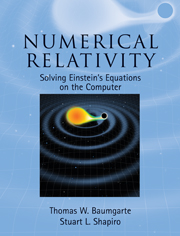Book contents
- Frontmatter
- Contents
- Preface
- Suggestions for using this book
- 1 General relativity preliminaries
- 2 The 3 + 1 decompostion of Einstein's equations
- 3 Constructing initial data
- 4 Choosing coordinates: the lapse and shift
- 5 Matter sources
- 6 Numerical methods
- 7 Locating black hole horizons
- 8 Spherically symmetric spacetimes
- 9 Gravitational waves
- 10 Collapse of collisionless clusters in axisymmetry
- 11 Recasting the evolution equations
- 12 Binary black hole initial data
- 13 Binary black hole evolution
- 14 Rotating stars
- 15 Binary neutron star initial data
- 16 Binary neutron star evolution
- 17 Binary black hole–neutron stars: initial data and evolution
- 18 Epilogue
- A Lie derivatives, Killing vectors, and tensor densities
- B Solving the vector Laplacian
- C The surface element on the apparent horizon
- D Scalar, vector and tensor spherical harmonics
- E Post-Newtonian results
- F Collisionless matter evolution in axisymmetry: basic equations
- G Rotating equilibria: gravitational field equations
- H Moving puncture representions of Schwarzschild: analytical results
- I Binary black hole puncture simulations as test problems
- References
- Index
8 - Spherically symmetric spacetimes
Published online by Cambridge University Press: 05 March 2013
- Frontmatter
- Contents
- Preface
- Suggestions for using this book
- 1 General relativity preliminaries
- 2 The 3 + 1 decompostion of Einstein's equations
- 3 Constructing initial data
- 4 Choosing coordinates: the lapse and shift
- 5 Matter sources
- 6 Numerical methods
- 7 Locating black hole horizons
- 8 Spherically symmetric spacetimes
- 9 Gravitational waves
- 10 Collapse of collisionless clusters in axisymmetry
- 11 Recasting the evolution equations
- 12 Binary black hole initial data
- 13 Binary black hole evolution
- 14 Rotating stars
- 15 Binary neutron star initial data
- 16 Binary neutron star evolution
- 17 Binary black hole–neutron stars: initial data and evolution
- 18 Epilogue
- A Lie derivatives, Killing vectors, and tensor densities
- B Solving the vector Laplacian
- C The surface element on the apparent horizon
- D Scalar, vector and tensor spherical harmonics
- E Post-Newtonian results
- F Collisionless matter evolution in axisymmetry: basic equations
- G Rotating equilibria: gravitational field equations
- H Moving puncture representions of Schwarzschild: analytical results
- I Binary black hole puncture simulations as test problems
- References
- Index
Summary
Turn now from the most general spacetime in full 3 + 1 dimensions to the special case of spherical symmetry. Why should we do this? Actually, spherical systems provide very useful computational, physical and astrophysical insight and working with them serves multiple purposes. The field equations reduce to 1 + 1 dimensions – variables may be written as functions of only two parameters, a time coordinate t and a suitable radial coordinate r – and are much simpler to solve in spherical symmetry. Solving them is a very cost-effective way of probing dynamical spacetimes with strong gravitational fields, including spacetimes with black holes. After all, nonrotating stars and black holes are themselves spherical, so many important aspects of gravitational collapse, including black hole formation and growth, can be studied in spherical symmetry. For example, the numerical study of spherically symmetric collapse to black holes led to the discovery of critical phenomena in black hole formation. The simplification in the equations, together with the reduction in the number of spatial dimensions, means that the system of spherical equations can be solved more quickly, in terms of both human input and computer time, and with much higher accuracy, than the set required for more general spacetimes. As a result, tackling problems in spherical symmetry provides an excellent starting point for learning how to do numerical relativity. It also serves as a convenient laboratory for experimenting with different gauge choices (coordinates) and for generating high precision, test-bed solutions for numerical codes designed to work in higher dimensions.
- Type
- Chapter
- Information
- Numerical RelativitySolving Einstein's Equations on the Computer, pp. 253 - 310Publisher: Cambridge University PressPrint publication year: 2010



